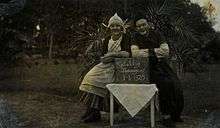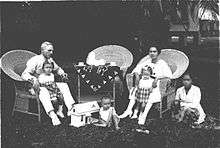Totok
Totok is an Indonesian term of Javanese origin, used in Indonesia to refer to recent migrants of Arab, Chinese or European origins.[1][2][3][4] In the eighteenth and nineteenth centuries it was popularised among colonists in Batavia, who initially coined the term to describe the foreign born and new immigrants of "pure blood" – as opposed to people of mixed indigenous and foreign descent, such as the Peranakan Arabs, Chinese or Europeans (the latter being better known as the Indo people).[3][5][4]

When more pure-blooded Arabs, Chinese and Dutchmen were born in the East Indies, the term gained significance in describing those of exclusive or almost exclusive foreign ancestry.[1][3][4]
'Peranakan' is the antonym of 'Totok', the former meaning simply 'descendants' (of mixed roots), and the latter meaning 'pure'.[4][6]
Notable Dutch Totoks and descendants

- Paul Acket (Semarang, Java, 1922), founder of the North Sea Jazz festival
- Albert Alberts (1911–1995), award winning author, journalist
- Beb Bakhuys (1909–1982), football player and manager
- Ben Bot (born in Batavia) (b. 1937), minister
- Hans van den Broek (b. 1936), minister
- Jeroen Brouwers (b. 1940), author
- Conrad Busken Huet (1826–1886), newspaper editor on Java (1868–1876)
- Louis Couperus (1863–1923), childhood in Batavia, Java (1871–1877), author of The Hidden Force (1900)
- P. A. Daum (1850–1898), newspaperman, author
- Johan Fabricius (1899–1981), author of De Scheepsjongens van Bontekoe (1923)
- Anthony Fokker (Blitar, Java, 1890–1939), aviation pioneer
- Hella Haasse (Batavia, Java, 1918–2011), award winning author
- Erik Hazelhoff Roelfzema (Surabaya, Java, 1917–2007), decorated World War II hero
- W. R. van Hoëvell (1812–1879), church minister of Batavia, political activist (1838–1848)
- Xaviera Hollander (b. 1943), author
- Rudy Kousbroek (1929–2010), author
- Liesbeth List (b. 1941), singer
- Multatuli (1820–1887), resident on Ambon and Java (1838–1858), iconic author
- Willem Nijholt, artist, singer
- Willem Oltmans (1925–2004), journalist, author
- Helga Ruebsamen (1934–2016), author
- F. Springer (1932–2011), author
- Bram van der Stok (Plaju, Sumatra, 1915–1993), decorated World War II hero
- Madelon Szekely-Lulofs (Surabaya, 1899–1958) author of Rubber(1931)[7] and Koelie (1931)[8]
- Peter Tazelaar (Bukittingi, Sumatra, 1922–1993), decorated World War II hero
- Edgar Vos (Makassar, 1931-2010), fashion designer
- Margaretha Geertruida Zelle (1876–1917), known as Mata Hari, exotic dancer, spy
References
Citations
- Ulbe Bosma & Remco Raben. Being "Dutch" in the Indies: A History of Creolisation and Empire, 1500–1920 (11 April 1996 ed.). National University of Singapore Press. pp. 186–286. ISBN 978-0-89680-261-2.
- Charles A. Coppel, "Diaspora and hybridity: Peranakan Chinese culture in Indonesia", in Routledge Handbook of the Chinese Diaspora, edited by Chee-Beng Tan, pp. 346-347
- Mobini-Kesheh, Natalie (1999). The Hadrami Awakening: Community and Identity in the Netherlands East Indies, 1900-1942. Singapore: SEAP Publications. ISBN 978-0-87727-727-9. Retrieved 3 December 2019.
- Rush, James R. (2007). Opium to Java: Revenue Farming and Chinese Enterprise in Colonial Indonesia, 1860-1910. Sheffield: Equinox Publishing. ISBN 978-979-3780-49-8. Retrieved 3 December 2019.
- Willems, Wim "Tjalie Robinson; Biografie van een Indo-schrijver" Chapter: Een Totok als vader (Publisher: Bert Bakker, 2008) p. 45 ISBN 9789035133099.
- Tan, Mely G. (2008) (in English and Indonesian), Etnis Tionghoa di Indonesia: Kumpulan Tulisan [Ethnic Chinese in Indonesia: Collected Writings] (Jakarta: Yayasan Obor Indonesia, 2008) ISBN 978-979-461-689-5 p. 1
- Rubber by Madelon Szekely-Lulofs on DBNL website.
- Koelie by Madelon Szekely-Lulofs on DBNL website.
Bibliography
- Bosman, Ulbe and Raben, Remco. De oude Indische wereld 1500–1920. (Bert Bakker, Amsterdam 2003) ISBN 90-351-2572-X (in Dutch)
- Sastrowardoyo, Subagio Sastra Hindia Belanda dan kita (Publisher: PT Balai Pustaka, Jakarta, 1990) p. 21 ISBN 979-407-278-8 (in Indonesian)
- Taylor, Jean Gelman. The Social World of Batavia: European and Eurasian in Dutch Asia (Madison: The University of Wisconsin Press, 1983). ISBN 9780300097092
- Taylor, Jean Gelman. Indonesia: Peoples and Histories (New Haven: Yale University Press, 2003). ISBN 0300097093